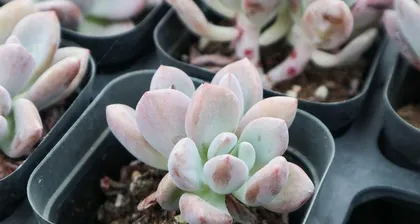Opulina is a potted plant with high ornamental value, loved by many plant enthusiasts. However, to let Opulina thrive, choosing the right pot is very important. This article will introduce how to select and use suitable pots to create a beautiful Opulina potted plant.

I: Pot Selection
When selecting a pot for Opulina, you should first consider the size of the root system. Since Opulina's roots are relatively shallow and weak, it is recommended to choose a wide but not deep pot. Additionally, when purchasing a pot, you should also pay attention to the pot material. Ceramic pots have good permeability and can maintain appropriate humidity, making them a better choice.
II: Pot Size
The size of Opulina's pot directly affects its growth state. A pot that is too large or too small will affect the healthy growth of Opulina. Generally speaking, the diameter of Opulina's pot should be around 25-30 cm, and the height should be controlled at about 20 cm. This can provide enough growing space for Opulina.

III: Pot Color
When selecting a pot for Opulina, the color of the pot is also a factor to consider. It is recommended to choose light-colored pots, which can reflect sunlight and maintain an appropriate temperature. Dark-colored pots will absorb sunlight, causing the temperature to be too high and affecting the growth of Opulina.
IV: Pot Material
In terms of pot materials, besides ceramic pots, there are also plastic and cement materials. Among them, plastic pots are easy to move and clean, and have good air permeability and moisture retention effects, but they should not be too conspicuous. Cement pots are relatively heavy, but have better insulation and moisture retention effects.
V: Soil Selection
Opulina needs loose, breathable, and well-drained soil. A common soil formula is a mixture of peat moss, perlite, vermiculite, and yellow sand. When selecting soil, avoid using overly fertile soil, otherwise it will cause Opulina to grow too vigorously and be difficult to control.

VI: Drainage Design
Opulina's pot needs good drainage design. It is recommended to place a layer of peat moss or stones at the bottom of the pot to enhance drainage. In addition, to avoid waterlogging of the roots, you can set up drainage holes to allow excess water to flow out on its own.
VII: Insulation Effect
Since Opulina is a tropical plant, it needs to maintain an appropriate temperature. In winter, you can add an insulating cover to the Opulina pot or place it in a greenhouse. Also, in summer, avoid direct sun exposure and place the pot in a cool place.
VIII: Fertilizer Application
Opulina's pot needs regular fertilizer application. Generally, spring and summer are the peak growing seasons for Opulina, and the frequency of fertilization can be appropriately increased. It is recommended to use organic fertilizers and avoid chemical fertilizers to prevent damage to Opulina's roots.
IX: Watering Frequency
Opulina needs to maintain appropriate humidity, but it cannot be too wet. Generally, in summer, it should be watered once a week, and in winter, the frequency of watering should be reduced to about once every two weeks. Also, when watering, control the amount of water to avoid water accumulation in the pot.
X: Leaf Management
Opulina's leaves need to be wiped frequently to keep the leaf surface clean. Dust and stains on the leaves will affect Opulina's photosynthesis and limit growth. Also, pay attention to leaf pruning and trimming to keep Opulina in an elegant shape.
XI: Irrigation Method
When watering Opulina, a slow and uniform irrigation method should be adopted. You can choose drip irrigation or pouring methods to allow water to fully penetrate the soil and keep the roots moist.
XII: Transplant Management
Opulina's pot needs regular transplantation. Generally, spring is the best time for transplantation every year. During transplantation, be careful not to damage Opulina's roots, and also choose a pot of appropriate size.
XIII: Pest Control
Opulina may be attacked by pests such as aphids and whiteflies. When pests are found, timely control measures should be taken, and methods such as soap water and masson pine essential oil can be used for insect repellent.
XIV: Sunlight Management
Opulina needs sufficient sunlight to grow lushly. In summer, choose a shading net or move it to a cool place to avoid direct sunlight. In winter, choose sufficient indoor lighting to ensure the growth of Opulina.
XV:
Through the introduction of the above 15 aspects, we can find that choosing the right pot is crucial for the growth of Opulina. Special attention should also be paid to pot selection, soil formula, and watering frequency. Only by mastering comprehensive pot care knowledge can you create a healthy and beautiful home for your Opulina.
<|end_of_box|>